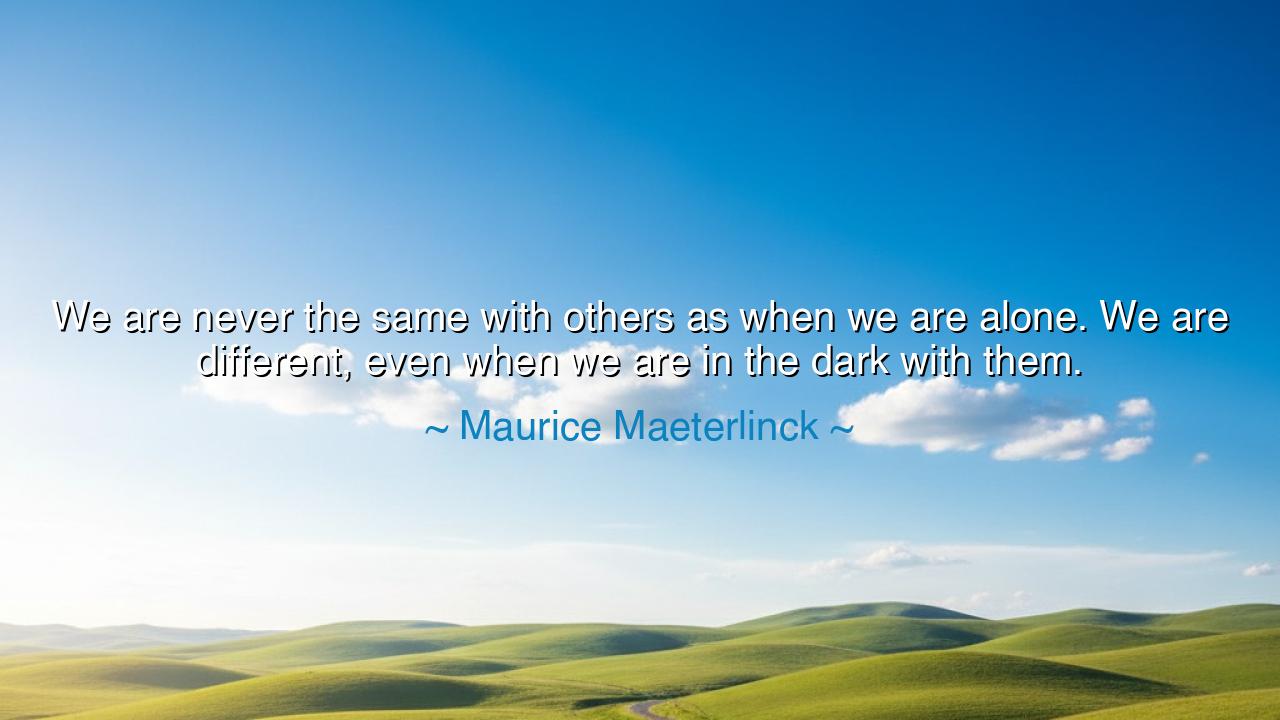
We are never the same with others as when we are alone. We are
We are never the same with others as when we are alone. We are different, even when we are in the dark with them.






The words of Maurice Maeterlinck — “We are never the same with others as when we are alone. We are different, even when we are in the dark with them.” — speak to one of the deepest mysteries of the human soul: the duality of being, the hidden difference between the face we show the world and the essence we encounter in solitude. In this simple yet haunting sentence, Maeterlinck, poet and philosopher of silence, unveils the eternal tension between the outer self and the inner self. He tells us that no matter how intimate our relationships, how close our companionships, a part of us remains untouched, unseen — a realm known only to ourselves, and perhaps to eternity.
To understand these words is to step into the twilight of self-awareness, where truth is both luminous and unsettling. When Maeterlinck says, “we are different, even when we are in the dark with them,” he evokes the moments of greatest closeness — when two souls share silence, vulnerability, even love — and yet remain separate, each enclosed within its own consciousness. The darkness here is not merely literal; it is symbolic. It represents the stripping away of appearances, the moments when pretense fades. And still, he says, we are not entirely known. The human being, for all its capacity for empathy and connection, remains an island of mystery, surrounded by an ocean of solitude.
This insight finds echoes in every age. The philosopher Pascal once wrote that “all of humanity’s problems stem from man’s inability to sit quietly in a room alone.” Maeterlinck extends this truth further — suggesting that even when we are not alone, even surrounded by others, we carry our solitude within us. There is always a hidden current beneath the surface of speech, an unseen distance between souls. No word, no gesture, no embrace can fully bridge that distance. For the soul, like the moon, always shows only one side to the world; its dark half belongs to silence.
And yet, this separation is not sorrowful — it is sacred. The mystery of individuality is what gives life its depth. Consider the story of Emily Dickinson, who lived much of her life in seclusion, yet wrote poems that touched the hearts of generations. Even among those few who loved her, she remained largely unknowable. Her letters, filled with light and shadow, reveal a soul more vast than any relationship could contain. In solitude, she communed not with absence, but with presence — the presence of her own being. Maeterlinck’s words capture this paradox: that to be human is to long for communion, yet to remain eternally singular.
At the same time, Maeterlinck warns us of the mask we wear before others. When we step into society — even into friendship or love — we unconsciously shape ourselves to fit the gaze of another. We smile when we are weary, we agree when we doubt, we pretend to be fearless when we tremble. It is not deception, but adaptation — the soul’s instinct to survive in the shared world. Yet, when we return to solitude, when no eyes watch us and no voice calls us, the true self rises — quieter, more fragile, but more real. Thus, his words are a mirror: they challenge us to ask, Who am I when no one is looking? For only in that question does self-knowledge begin.
There is a subtle melancholy in Maeterlinck’s thought, yet also great wisdom. He reminds us that no bond, however deep, can erase the solitude at the core of our being. But he also invites us to cherish that solitude, not as a burden, but as a gift. For it is within that inner darkness — that secret chamber of thought and emotion — that our creativity, conscience, and truth are born. The solitude within us is not emptiness, but the workshop of the soul. Those who learn to befriend it do not fear the spaces between themselves and others; they walk within them like sages.
The lesson, then, is not to despair of our separateness, but to honor it. Recognize that every person you meet carries within them an invisible world — vast, private, unknowable. Approach others with humility, for you see only their surface. Seek connection, but do not demand complete understanding, for that is reserved for the divine. And most importantly, do not flee from your own solitude. Sit with it. Listen to it. There, in the quiet, you will encounter the truth of who you are — the self that is not shaped by eyes, nor altered by presence.
So, O seeker of wisdom, remember Maeterlinck’s insight: we are never the same with others as when we are alone. There is a time for communion, and a time for silence; a time to share your light, and a time to guard your flame. Embrace both the companionship of the world and the solitude of your soul, for each completes the other. When you can walk among others and still remain inwardly whole — when you can stand in the dark beside another and yet know your own light — then you will have touched the secret harmony that lies between separation and unity, between the visible self and the eternal soul.






AAdministratorAdministrator
Welcome, honored guests. Please leave a comment, we will respond soon